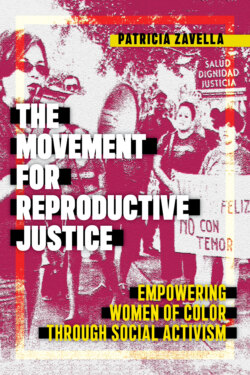Читать книгу The Movement for Reproductive Justice - Patricia Zavella - Страница 11
На сайте Литреса книга снята с продажи.
The Praxis of Intersectionality
ОглавлениеIntersectionality has been a capacious theoretical framework for understanding political praxis that includes legal and policy advocacy to remedy discrimination based simultaneously on race and gender. Kimberlé Crenshaw, widely attributed as having coined the term “intersectionality,” states, “While the primary intersections that I explore here are between race and gender, the concept [intersectionality] can and should be expanded by factoring in issues such as class, sexual orientation, age, and color.”95 Intersectionality illuminates social movements that engage with multiple forces, as well as how women’s subjectivities, identities, and emotions shape their expressions of agency.96 Key texts that analyze politics using an intersectional approach illustrate the flexibility that activists must cultivate as they negotiate dynamics of difference and sameness in relation to axes of power around gender, race, or sexuality in local movement contexts even when activism takes place in international venues.97
An intersectional approach includes four major components: (1) Intersectionality is an epistemological practice that looks for alternative sources of knowledge to help fill the gaps in understanding and silences in the historical record, legal documents, scholarship, and discourses about citizenship and human rights that ignore women of color. Besides drawing on primary research, reproductive justice advocates also draw on spirituality, cultural practices, vernacular knowledge, and the senses in their analyses of social problems and expressions of identity. (2) Intersectionality is also an ontological project that accounts for multiple identities and complex subjectivity and reconceptualizes agency while acknowledging the simultaneity of privilege and oppression.98 Reproductive justice activists are quick to highlight the needs and agency of those who are structurally vulnerable within communities of color, such as gender-nonconforming or trans people or undocumented immigrants, and call on those who have privileges—such as advanced educational degrees—to advocate on behalf of everyone. (3) Intersectionality engages in coalitional politics grounded in solidarity rather than sameness, which is strategically constructed while working to eradicate inequalities. (4) Intersectionality is also a resistant imaginary that disrupts dominant social discourses about people of color and intervenes in historical memory, often using artwork or narratives.99 The feminist scholar Vivian May adroitly sums up how an intersectional approach to reproductive justice addresses a broad range of issues including “widespread poverty and an ever-increasing wage gap; environmental hazards and pollution in poor rural and urban areas; increased disparities in access to health care and in life span and rates of illness; immigration and citizenship policies which unduly impact women; ongoing anti-natalist policies and practices with regard to disability; race, poverty, and citizenship; endemic and escalating forms of violence against women, much of which remains underreported and unaddressed; and intensified rates and forms of incarceration and their gendered politics and implications.”100 Emphasizing the simultaneous coconstruction of race with gender, class, and sexuality places reproductive justice advocates at odds with those who see race as primary.101 As TWU environmental justice manager Beata Tsosie-Peña observed during a presentation on reproductive justice, “It’s important that we bring our whole selves into these spaces and these movements.”102 In an interview, Cristina Aguilar affirmed, “In reproductive justice, you’re not checking any identities at the door; in fact, you’re really invited to do the opposite, to show up in all of your identities, your hopes, your dreams.”
Women of color theorists also see intersectionality as rooted in a colonial matrix of power, which has multiple implications.103 The Peruvian sociologist Anibal Quijano argues, “What is termed globalization is the culmination of a process that began with the constitution of America and colonial/modern Eurocentered capitalism as a new global power. One of the fundamental axes of the model of power is the social classification of the world’s population around the idea of race, a mental construction that expresses the basic experience of colonial domination and pervades the more important dimensions of global power, including its specific rationality, Eurocentrism.”104 The sociologist and feminist philosopher Maria Lugones makes a critical intervention to this formulation by pointing out that coloniality of power glosses patriarchal and heteronormative discourses imposed by colonialism and calls for critiques of racialized, capitalist, and gender oppression.105 The Bolivian feminist subaltern theorist Silvia Rivera Cusicanqui argues, “the possibility of a profound cultural reform in our society depends on the decolonization of our gestures and acts and the language with which we name the world.”106 Indeed, the feminist theorist Laura Pérez further suggests that “feminist queer of color critical thought is central to the work of decolonization,” and “we must undertake [the critique] collectively, in solidarity, and alongside the critique of our own subject formations.”107 By theorizing the origins of social constructs related to race, class, gender, and sexuality in coloniality rather than bodies, the movement directs attention to the anthropologists Jonathan Rosa and Yarimar Bonilla’s observation that modern colonialism is a “practice of violence, assemblage, superordination, exploitation, and segregation,” as well as the interdisciplinary scholar Maylei Blackwell’s insight that the coloniality of power also generates new forms of organizing.108
It is vital to consider the importance of place and focus on organizations that include the perspectives of those who are multiply marginalized by institutions, women of color with low incomes like Lola.109 I analyze how women of color in reproductive justice organizations contest structural processes of power within particular contexts in relation to one another and simultaneously see activism on behalf of women as integral to the well-being of all.110 I also illustrate how women of color construct political strategies and identities while attempting to end reproductive injustice.
